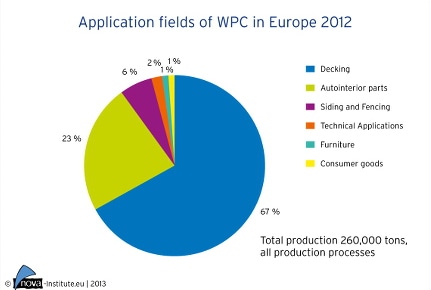 The market report "Wood-Plastic Composites (WPC) and Natural-Fibre Composites (NFC): European and Global Markets 2012 and Future Trends", conducted by the nova-Institute (Germany) in cooperation with Asta Eder Composite Consulting (Austria/Finland), gives the first comprehensive and detailed picture of the use and amount of wood and natural fibre reinforced composites in the European bio-based economy. The analysis covers natural fibre as well as wood-plastic composites in extrusion, injection and compression moulding in different branches and applications.
The market report "Wood-Plastic Composites (WPC) and Natural-Fibre Composites (NFC): European and Global Markets 2012 and Future Trends", conducted by the nova-Institute (Germany) in cooperation with Asta Eder Composite Consulting (Austria/Finland), gives the first comprehensive and detailed picture of the use and amount of wood and natural fibre reinforced composites in the European bio-based economy. The analysis covers natural fibre as well as wood-plastic composites in extrusion, injection and compression moulding in different branches and applications.To achieve a reliable base of data, the study draws from a survey conducted in 2013 among the WPC and NFC industry, producers and customers. The rate of return was exceptionally high, especially for the WPC part of the study, more than 50% of the extruded volume produced took part in the survey - that means the study covers about 65 European WPC extruding companies in 21 countries.
The total volume of WPC production in Europe was 260,000 tonnes in 2012 (plus 90,000 tonnes Natural Fibres Composites for the automotive industry, see below). The level of market penetration of bio-based composites varies between different regions and application fields. Germany leads in terms of number of actors as well as in production figures. The typical production process in Europe is extrusion of a decking profile based on a PVC or PE matrix. The increasing market penetration of WPC has meant that WPC volumes have risen strongly and that today, Europe has reached a mature WPC market stage. This study predicts growth especially in the German-speaking area on the back of a recovery in construction, especially in renovation, and a further increase of WPC share in the highly competitive decking market. Also, variations of WPC decking models, such as capped embossed full profiles or garden fencing are on the rise across Europe.
The development in shares of applications points to a direction where WPC is increasingly used for applications beyond the traditional ones such as decking or automotive parts. For example, WPC is increasingly used to produce furniture, technical parts, consumer goods and household electronics, using injection moulding and also other processes than extrusion. Also new production methods are being developed for extrusion of broad WPC boards.
Figure 1 shows the different application fields of WPC produced in Europe. The decking market is leading with 67% (mainly extrusion), followed by automotive interior parts with 23% (mainly compression moulding and sheet extrusion as well as thermoforming). Although still smaller, siding and fencing as well as technical applications (mainly extrusion) and consumer goods and furniture (mainly injection moulding) are showing the highest increase in percentage. With increasing plastic prices, WPC granulates for injection moulding are getting more and more attractive, and are increasingly found in the product range of the European granulate suppliers.



